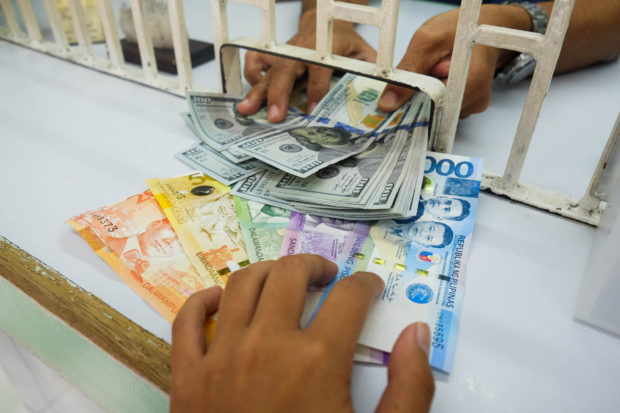Pressured peso nears 17-year low vs US dollar
MANILA, Philippines — The Philippine peso slid further to 54.265 against the US dollar — still at its weakest in three years and eight months or since October 2018 — after brushing near a 17-year low at 54.40:$1.
And while this may be partly due to the greenback getting even more attractive to investors following the US Federal Reserve’s 75-basis-point interest rate hike last week coupled with hints of more to come, it may also be due to the lack of corresponding aggressiveness from the Bangko Sentral ng Pilipinas (BSP).
Analysts have noted the narrowing gap between US and Philippine interest rates, especially with the US Fed tightening faster while the BSP appears bent to take its time with small increments.
BSP Governor Benjamin Diokno has reiterated that the Philippine central bank did not need to raise policy rates in lockstep with its American counterpart. Earlier this week, Diokno said the rate hike expected on Thursday was likely at 25 bps.
Differing policies
Nicholas Mapa, a senior Philippines economist at ING Bank, also reiterated that the current situation was akin to 2018 when differing policy directions between the BSP and the rest of the world caused the peso to weaken by more than 9 percent. This, in turn, shaved off $7 billion from the Philippines’ gross international reserves as the BSP defended the peso.
Mapa noted that while the peso traded at a low of 54.40:$1 on Tuesday, it similarly did so at 54:33:$1 four years ago. At the same time, inflation is currently pegged at 5.4 percent compared to 6.9 percent previously.
“However, [BSP’s policy] rate is now 2.25 percent [compared to] 4.75-percent peak back then,” he added.
Mapa thus argued that the BSP should again raise its overnight borrowing rate by at least 50 bps when the Monetary Board meets on June 23.
Last week, Bank of the Philippine Islands lead economist Emilio Neri Jr. pointed out that the difference between US Fed and BSP policy rates are now at their narrowest ever—50 bps to 75 bps. The perceived lack of an adequate risk premium prompts investors to instead park funds in the less risky US market. Diokno, however, remains unfazed.
“The best way to look at the peso devaluation is, how is it [faring] in relation to other currencies in the region?,” Diokno said on Tuesday. “If you [make the comparison], we are doing well.”
Strong fundamentals
According to the Department of Finance (DOF), based on data as of May, strong macroeconomic fundamentals continue to support the peso, despite external headwinds from tighter monetary policy actions by the US Fed and inflationary pressures from heightened global fuel prices.
The DOF said last week that the Philippine peso continued to be in the middle of the pack of the most stable currencies in Asia as the region recovered from the pandemic and imports of capital goods soared.
“In 2022, the peso was one of the strongest Asian currencies, ranking second only to the Vietnamese dong,” the DOF said.
Also on Tuesday, the BSP-led Financial Stability Coordination Council (FSCC) noted that rising inflation in advanced economies has led their central banks to raise policy rates to temper economic activity.
“This is not the situation in many emerging markets, but the rate increases are expected to spill over to the rest of the world,” Diokno said, speaking as FSCC chair.
“We expect spillovers from the advanced economies to emerging market economies through cost-push pressures and higher risk premiums,” he said. “These are not independent shocks but are interconnected at many levels, creating complex, nonstationary and interlinked cause-and-effect relationships.”
RELATED STORIES
PSEi inches closer to one-year low
PSEi defends 6,300 barrier amid heightened inflation worries
